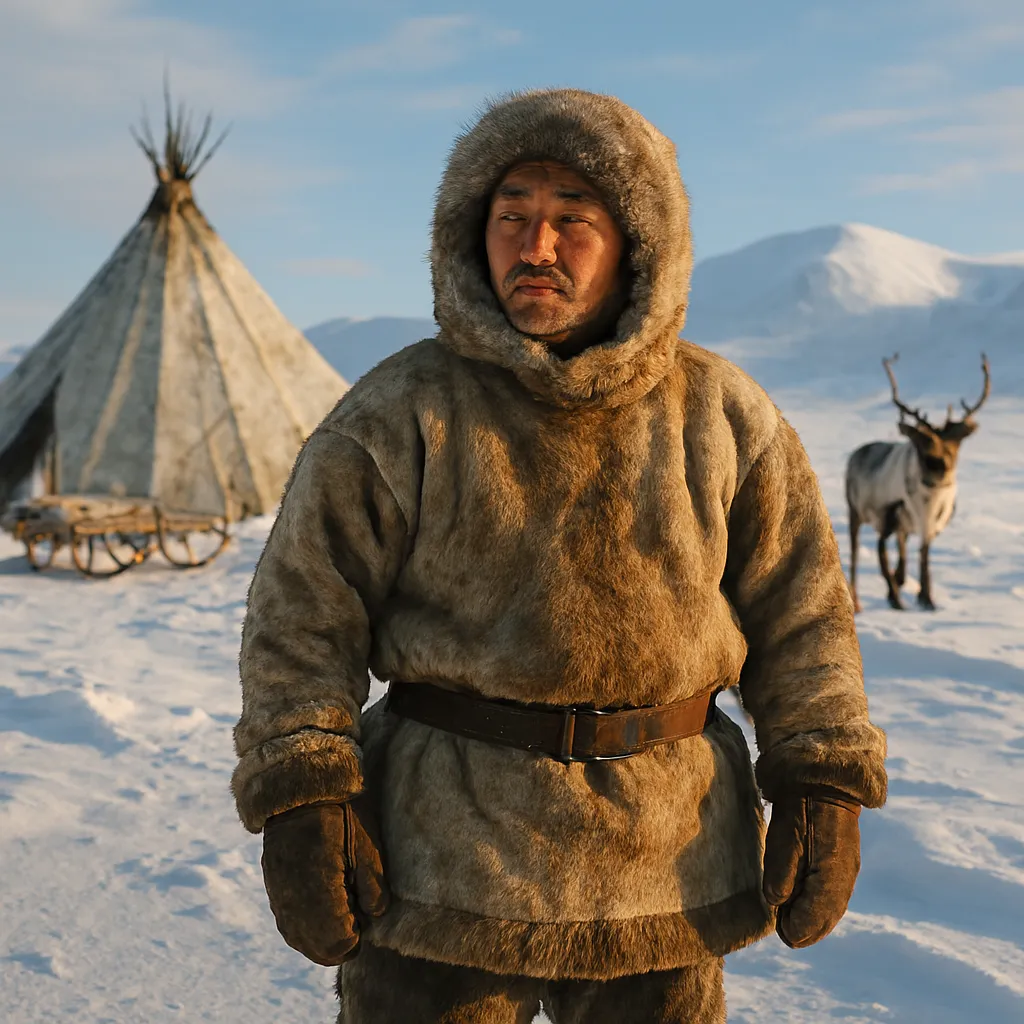The Chukchi are an Indigenous people of northeastern Asia, chiefly in Russia’s Chukotka Autonomous Okrug. Their language is Chukchi (Chukotko‑Kamchatkan), with widespread bilingualism in Russian. Belief blends animism and shamanism with elements of Orthodoxy. Everyday ethics value reserve, hard work, hospitality, and respect for elders; aggressiveness is discouraged, with disputes traditionally mediated by elders and “song duels.” Alcohol is approached cautiously, with community sobriety efforts; narcotics are rejected. Popular sports include sled‑team racing, lasso‑throwing onto a pole, Arctic all‑around, wrestling, tug‑of‑war, plus cross‑country skiing, track‑and‑field events, futsal, and winter board games.
History
Ethnogenesis is tied to late‑Holocene adaptation to tundra and to marine resources and reindeer herding. The 17th–18th centuries saw fierce clashes with Russian forces and conflicts with Koryaks, alongside expanding trade in metal goods, furs, and walrus ivory. By the late 18th century, sustained peace and exchange prevailed, followed by deeper administrative integration in imperial and Soviet eras. The 20th century brought partial sedentarization, collectivized livelihoods, schooling and clinics, and a language shift. The 1990s brought crisis and migration; the 21st century shows stabilization, support for traditional livelihoods, language and craft revitalization, and growing ethnotourism.
Name origin
“Chukchi” derives from the term “chauchu,” “rich in reindeer,” used for inland herders; coastal groups call themselves “ankalyn,” “sea people.” Broader self‑designations include “orawetl’et,” “yg’orawetl’et,” and “Luoravetlan,” meaning “(real) people.”
Occupation
Traditionally: nomadic reindeer herding, marine hunting (seal, walrus, whale), fishing, gathering, sled‑dog transport, bone carving, and skin sewing. Today: a mix of traditional livelihoods with work in education, health care, culture, and administration; some employment in services, logistics, geology, and extractive industries; cooperatives, crafts, and ethno-/ecotourism are developing.
Physical description
Common traits include dark hair, brown eyes, light‑olive to tan skin, and compact builds adapted to cold. Average stature ranges from short to medium, with wide individual variation. Racial typologies are outdated; internal phenotypic diversity is notable.
Habitat
Historical range: the Chukchi Peninsula and adjoining tundra from the Bering and Chukchi Seas to the Anadyr basin, upper Kolyma, and northern Kamchatka; seasonal contacts with Alaska across the Bering Strait. Today: chiefly Russia—Chukotka, plus Kamchatka, Magadan, Yakutia, and major Siberian and Far Eastern cities; continent: Asia.
Wars and conflicts
In the 17th–18th centuries there were wars and raids involving Russian detachments and local conflicts with Koryaks and some Yupik groups over pastures and resources. Within communities, disputes were governed by customary law, compensation, elder mediation, and cultural practices like “song duels.” In recent times, legal and negotiated mechanisms prevail.
Population
Trends: about 11–12 thousand in the mid‑20th century; ≈15.2 thousand (1989); 15,767 (2002); 15,908 (2010); around 16,200 (2021). Soviet‑era growth reflects expanded health care and social services; 1990s declines stemmed from economic crisis and out‑migration; recent years show relative stabilization. Fluency in Chukchi declined, with active educational and media initiatives to support it.
Traditions, rituals, festivals
Offerings to spirits after successful hunts, naming children after ancestors, seasonal taboos, and cleansing rites. Reindeer Herder’s Festival (March–April): sled races, lasso‑throwing, wrestling, dancing. Sea Festival (June): songs, dances, remembrance of animals. Whale Festival—after a successful hunt (variable date): sharing the catch and communal feasts. Also observed: August 9, International Day of the World’s Indigenous Peoples; plus regional public holidays.
Myths and legends
The world is alive with spirits of sea, wind, mountains, and animals; the shaman mediates realms, retrieving “lost souls” and securing luck. A raven trickster serves as culture hero and world‑maker. Epics explain the origins of animals, subsistence practices, natural phenomena, and the costs of breaking taboos.
Notability
Yuri Rytkheu is a world‑known writer who presented Chukchi culture; Vladimir Bogoraz‑Tan authored classic ethnographies of the Chukchi. Noted collectives and schools include the Uelen Bone Carving Studio and the “Ergyron” dance ensemble. The Chukchi appear in Russian and global literature, documentary film, and photography; bone carving is represented in museum collections.
Food
Diet centers on reindeer, marine mammals, fish (Pacific salmon, Arctic char), fats, berries, and roots. Traditional dishes include stroganina, yukola, blood and offal dishes, and rendered fat; on the coast—whale and walrus prepared in diverse ways. Raw or minimally processed foods help maintain vitamins in Arctic conditions.
Clothing
Winter wear includes fur‑in malitsa, outer parka, fur trousers, and mittens; footwear—torbasa with felt liners. Materials: reindeer hides; fox, wolf, and bear furs; along the coast—marine‑mammal skins and waterproof gut parkas (kamleikas). Decorations feature appliqué, beads, bone, and antler; cuts emphasize warmth, durability, and mobility.
Tourism
Ethno‑ and nature‑based routes are growing: Anadyr, Provideniya, Lorino, Lavrentiya, Egvekinot; visits to herding camps, bone‑carving workshops (Uelen), attending the Reindeer Herder’s Festival; with permits, cruises to Wrangel Island. Community groups and local operators host visitors; infrastructure is limited but growing—ethnovillages, cultural centers, guesthouses.
Visitor etiquette
Ask permission before photographing or entering homes; remove shoes indoors; don’t touch ritual items. Don’t pet sled dogs, step on sleds, or handle harness without consent; don’t interfere with hunting/fishing or fly drones near haul‑outs. Show deference to elders; small gifts are welcome; avoid offering alcohol. Coordinate visits with local guides and observe seasonal taboos and safety rules on sea ice and coastal waters.
- Dagestan: between the grandeur of nature and the challenges of tourism
- Tonga
- House of Russian-Korean Friendship Opened in Primorye on the Border with the DPRK
- How to follow Donald Trump’s travel trail
- And in Africa the mountains are this high
- Brest (Belarus)
- With a Movie Camera in Kamchatka
- Barack Obama: tourist places of his life and travels
- Sahalin
- Majestic Grand Canyon – Unique Nature of the USA
- Bosnia and Herzegovina
- Irkutsk
- Turtle facts
- Turkmenistan
- Lofoten Islands
- Dagestan
- Sumatra
- Pirate places of the world: where to travel for seafaring legends
- Tennant Creek 1988: the most powerful earthquake in Australia’s history
- Abkhazia











